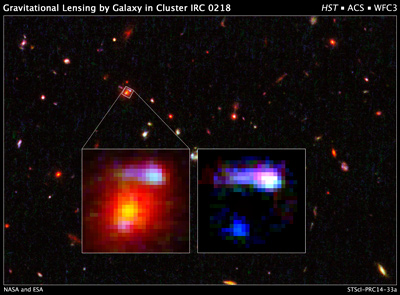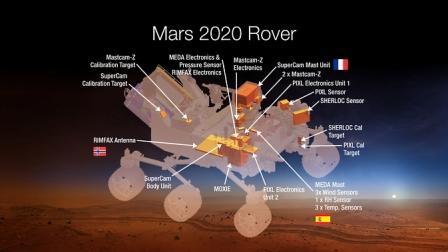
Gravitational Lensing by Galaxy in Cluster IRC 0218. Photo: NASA, ESA, K.-V. Tran (Texas A&M University), and K. Wong (Academia Sinica Institute of Astronomy & Astrophysics)
WASHINGTON (PTI): Astronomers using NASA's Hubble Space Telescope have discovered the most distant galaxy that acts as a cosmic magnifying glass.
At 9.6 billion light-years away, it could be the most distant such object known to science, researchers said.
Spotted in observations from the Keck Observatory in Hawaii and the Hubble Space Telescope, the galaxy is big enough to magnify an even more distant galaxy 10.7 billion light-years away, due to a phenomenon known as gravitational lensing.
Through lensing, the gravitational field of a massive foreground object bends, warps and magnifies the light from more distant objects.
This phenomenon can reveal extremely dim, faraway galaxies that astronomers otherwise would not be able to see, 'SPACE.com' reported.
When you look into the early universe, you don't expect to find this type of galaxy lensing at all, explained lead researcher Kim-Vy Tran of Texas A&M University in College Station.
"It's very difficult to see an alignment between two galaxies in the early universe. Imagine holding a magnifying glass close to you and then moving it much farther away," Tran said.
"When you look through a magnifying glass held at arm's length, the chances that you will see an enlarged object are high. But if you move the magnifying glass across the room, your chances of seeing the magnifying glass nearly perfectly aligned with another object beyond it diminishes," Tran said.
The newfound magnifying galaxy belongs to a distant galaxy cluster known as IRC 0218.
It is 180 billion times more massive than our Sun, and at 9.6 light-years away, it breaks the previous record-holder for most distant lensing galaxy by 200 million years, according to NASA.
The team suspects the lensing galaxy continued to grow over the past 9 billion years, gaining stars and dark matter by cannibalising neighbouring galaxies.
The results were published in The Astrophysical Journal Letters.
 Next Article
Next Article













The Indian Air Force, in its flight trials evaluation report submitted before the Defence Ministry l..
view articleAn insight into the Medium Multi-Role Combat Aircraft competition...
view articleSky enthusiasts can now spot the International Space Station (ISS) commanded by Indian-American astr..
view article